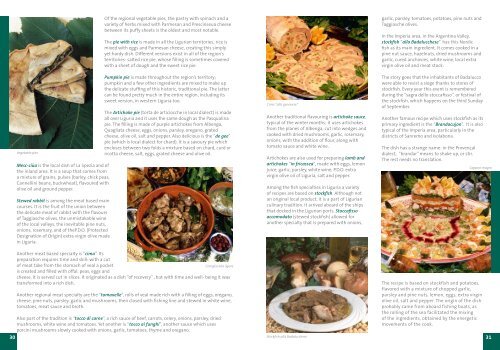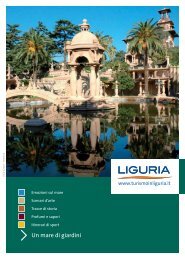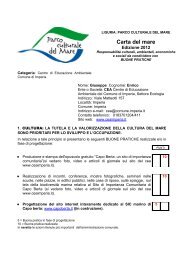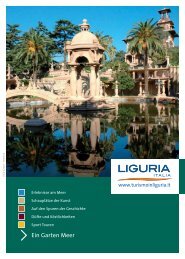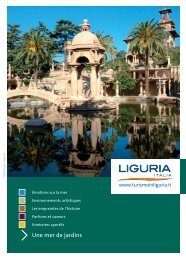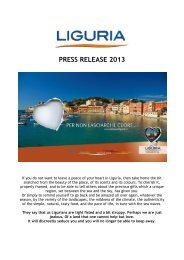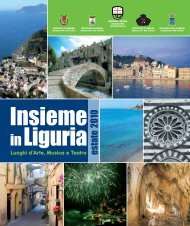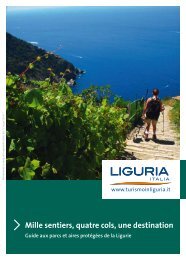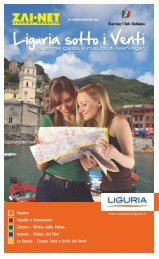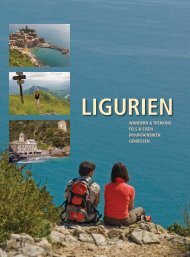Liguria, land of quality - Turismo in Liguria
Liguria, land of quality - Turismo in Liguria
Liguria, land of quality - Turismo in Liguria
You also want an ePaper? Increase the reach of your titles
YUMPU automatically turns print PDFs into web optimized ePapers that Google loves.
Vegetable pies<br />
Mesc-ciùa is the local dish <strong>of</strong> La Spezia and <strong>of</strong><br />
the <strong>in</strong><strong>land</strong> area. It is a soup that comes from<br />
a mixture <strong>of</strong> gra<strong>in</strong>s, pulses (barley, chick peas,<br />
Cannell<strong>in</strong>i beans, buckwheat), flavoured with<br />
olive oil and ground pepper.<br />
Stewed rabbit is among the meat based ma<strong>in</strong><br />
courses. It is the fruit <strong>of</strong> the union between<br />
the delicate meat <strong>of</strong> rabbit with the flavours<br />
<strong>of</strong> Taggiasche olives, the unmistakable w<strong>in</strong>e<br />
<strong>of</strong> the local valleys, the <strong>in</strong>evitable p<strong>in</strong>e nuts,<br />
onions, rosemary, and <strong>of</strong> theP.D.O. (Protected<br />
Designation <strong>of</strong> Orig<strong>in</strong>) extra virg<strong>in</strong> olive made<br />
<strong>in</strong> <strong>Liguria</strong>.<br />
Of the regional vegetable pies, the pastry with sp<strong>in</strong>ach and a<br />
variety <strong>of</strong> herbs mixed with Parmesan and Presc<strong>in</strong>seua cheese<br />
between its puffy sheets is the oldest and most notable.<br />
The pie with rice is made <strong>in</strong> all the <strong>Liguria</strong>n territories; rice is<br />
mixed with eggs and Parmesan cheese, creat<strong>in</strong>g this simply<br />
yet hardy dish. Different versions exist <strong>in</strong> all <strong>of</strong> the region’s<br />
territories: salted rice pie, whose fill<strong>in</strong>g is sometimes covered<br />
with a sheet <strong>of</strong> dough and the sweet rice pie.<br />
Pumpk<strong>in</strong> pie is made throughout the region’s territory;<br />
pumpk<strong>in</strong> and a few other <strong>in</strong>gredients are mixed to make up<br />
the delicate stuff<strong>in</strong>g <strong>of</strong> this historic, traditional pie. The latter<br />
can be found pretty much <strong>in</strong> the entire region, <strong>in</strong>clud<strong>in</strong>g its<br />
sweet version, <strong>in</strong> western <strong>Liguria</strong> too.<br />
The Artichoke pie (torta de articiocche <strong>in</strong> local dialect) is made<br />
all over <strong>Liguria</strong> and it uses the same dough as the Pasqual<strong>in</strong>a<br />
pie. The fill<strong>in</strong>g is made <strong>of</strong> purple artichokes from Albenga,<br />
Quagliata cheese, eggs, onions, parsley, oregano, grated<br />
cheese, olive oil, salt and pepper. Also delicious is the “de gee”<br />
pie (which is local dialect for chard). It is a savoury pie which<br />
encloses between two folds a mixture based on chard, curd or<br />
ricotta cheese, salt, eggs, grated cheese and olive oil.<br />
Cima “alla genovese”<br />
Another traditional flavour<strong>in</strong>g is artichoke sauce,<br />
typical <strong>of</strong> the w<strong>in</strong>ter months; it uses artichokes<br />
from the planes <strong>of</strong> Albenga, cut <strong>in</strong>to wedges and<br />
cooked with dried mushrooms, garlic, rosemary,<br />
onions, with the addition <strong>of</strong> flour, along with<br />
tomato sauce and white w<strong>in</strong>e.<br />
Artichokes are also used for prepar<strong>in</strong>g lamb and<br />
artichokes “<strong>in</strong> fricassea”, made with eggs, lemon<br />
juice, garlic, parsley, white w<strong>in</strong>e, P.D.O. extra<br />
virg<strong>in</strong> olive oil <strong>of</strong> <strong>Liguria</strong>, salt and pepper.<br />
Among the fish specialties <strong>in</strong> <strong>Liguria</strong> a variety<br />
<strong>of</strong> recipes are based on stockfish. Although not<br />
an orig<strong>in</strong>al local product, it is a part <strong>of</strong> <strong>Liguria</strong>n<br />
cul<strong>in</strong>ary tradition. It arrived aboard <strong>of</strong> the ships<br />
that docked <strong>in</strong> the <strong>Liguria</strong>n ports. Stoccafisso<br />
accomodato (stewed stockfish) allowed for<br />
another specialty that is prepared with onions,<br />
garlic, parsley, tomatoes, potatoes, p<strong>in</strong>e nuts and<br />
Taggiasche olives.<br />
In the Imperia area, <strong>in</strong> the Argent<strong>in</strong>a Valley,<br />
stockfish “alla Badalucchese” has this Nordic<br />
fish as its ma<strong>in</strong> <strong>in</strong>gredient. It comes cooked <strong>in</strong> a<br />
p<strong>in</strong>e nut sauce, hazelnuts, dried mushrooms and<br />
garlic, cured anchovies, white w<strong>in</strong>e, local extra<br />
virg<strong>in</strong> olive oil and meat stock.<br />
The story goes that the <strong>in</strong>habitants <strong>of</strong> Badalucco<br />
were able to resist a siege thanks to stores <strong>of</strong><br />
stockfish. Every year this event is remembered<br />
dur<strong>in</strong>g the “sagra dello stoccafisso”, or festival <strong>of</strong><br />
the stockfish, which happens on the third Sunday<br />
<strong>of</strong> September.<br />
Another famous recipe which uses stockfish as its<br />
primary <strong>in</strong>gredient is the “Brandacujon”. It is also<br />
typical <strong>of</strong> the Imperia area, particularly <strong>in</strong> the<br />
districts <strong>of</strong> Sanremo and Isolabona.<br />
The dish has a strange name: <strong>in</strong> the Provençal<br />
dialect, “brandar” means to shake up, or stir.<br />
The rest needs no translation.<br />
Cappon magro<br />
Another meat based specialty is “cima”. Its<br />
preparation requires time and skill: with a cut<br />
<strong>of</strong> meat take from the stomach <strong>of</strong> veal a pocket<br />
Coniglio alla ligure<br />
is created and filled with <strong>of</strong>fal, peas, eggs and<br />
cheese. It is served cut <strong>in</strong> slices. It orig<strong>in</strong>ated as a dish “<strong>of</strong> recovery” , but with time and well- be<strong>in</strong>g it was<br />
transformed <strong>in</strong>to a rich dish.<br />
Another regional meat specialty are the “tomaxelle”, rolls <strong>of</strong> veal made rich with a fill<strong>in</strong>g <strong>of</strong> eggs, oregano,<br />
cheese, p<strong>in</strong>e nuts, parsley, garlic and mushrooms, then closed with fish<strong>in</strong>g l<strong>in</strong>e and stewed <strong>in</strong> white w<strong>in</strong>e,<br />
tomatoes, meat sauce and broth.<br />
Also part <strong>of</strong> the tradition is “tocco di carne”, a rich sauce <strong>of</strong> beef, carrots, celery, onions, parsley, dried<br />
mushrooms, white w<strong>in</strong>e and tomatoes. Yet another is “tocco ai funghi”, another sauce which uses<br />
porc<strong>in</strong>i mushrooms slowly cooked with onions, garlic, tomatoes, thyme and oregano.<br />
The recipe is based on stockfish and potatoes,<br />
flavored with a mixture <strong>of</strong> chopped garlic,<br />
parsley and p<strong>in</strong>e nuts, lemon, eggs, extra virg<strong>in</strong><br />
olive oil, salt and pepper. The orig<strong>in</strong> <strong>of</strong> the dish<br />
probably came from aboard fish<strong>in</strong>g boats, as<br />
the roll<strong>in</strong>g <strong>of</strong> the sea facilitated the mix<strong>in</strong>g<br />
<strong>of</strong> the <strong>in</strong>gredients, obta<strong>in</strong>ed by the energetic<br />
movements <strong>of</strong> the cook.<br />
30 Stockfish alla Badalucchese<br />
31


